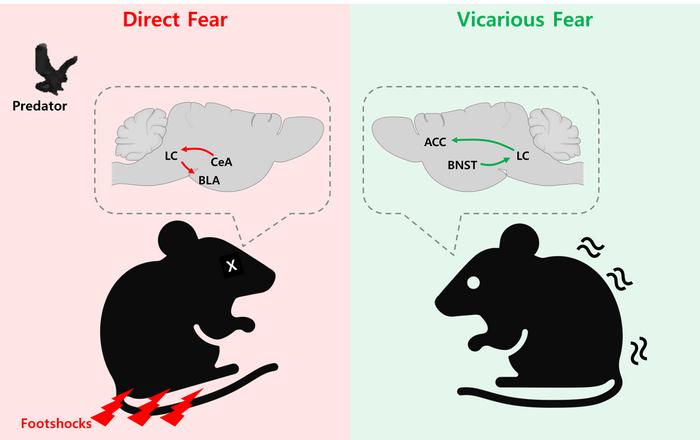The field of neuroscience continues to unlock the mysteries of how our brains process emotional experiences, particularly fear. A groundbreaking study led by Dr. SHIN Hee-sup at the Institute for Basic Science investigates the neural circuits involved in direct and vicarious fear, revealing fascinating insights that could reshape our understanding of emotional learning and empathy. This complex interplay has far-reaching implications not only for basic neuroscience but also for the treatment of psychiatric conditions that involve fear regulation.
Fear, an emotionally charged response, is typically regarded as a direct reaction to threats. In contrast, vicarious fear is experienced by observing others in distress. Think about the sensation of spine-tingling fear you might feel while watching a friend navigate a dangerous situation, even though you are safe. Dr. Shin’s research explores this phenomenon and identifies specific brain circuits that allow us to respond emotionally to the fear experienced by others.
At the heart of this investigation is the locus coeruleus (LC), a small brain structure in the brainstem responsible for the production of norepinephrine (NA). The findings from Dr. Shin’s team show that the LC operates in a lateralized manner, with its left and right halves playing distinct roles in processing different types of fear stimuli. This lateralization reveals a nuanced understanding of how fearful experiences are encoded in the brain and challenges prior assumptions about uniform fear processing.
Traditionally, much of the neuroscience community has focused on regions like the amygdala and the anterior cingulate cortex (ACC) when studying fear responses. While these areas are undoubtedly important, the newfound emphasis on the LC opens new pathways for exploration. Importantly, it raises questions about whether the LC treats direct fear, such as personal threats, in the same way as it does vicarious fear, where the threat is observed rather than experienced firsthand.
To uncover these neural secrets, the research team employed a multitude of advanced techniques that included optogenetics, fiber photometry, and viral tracing. This combination of methodologies allowed for real-time observation and manipulation of neural activity. They hypothesized that the right hemisphere of the LC would correlate specifically with fear learned through observation, potentially implicating the right LC-ACC circuitry as crucial for understanding vicarious fear responses.
One of the pivotal experiments involved using optogenetic techniques to selectively inhibit neural pathways in mice while they observed another mouse undergoing a mild electric shock. This setup was designed to create a model for vicarious fear, allowing researchers to observe how the observing mouse responded emotionally to the distress of another. Astonishingly, when the right LC-ACC circuit was deactivated, the observing mouse exhibited no freezing behavior, which is a hallmark of fear response, highlighting the importance of this neural circuit in processing vicarious fear.
In further supporting this connection, researchers discovered that the circuit relied on β-adrenergic receptors located in the right ACC. Administering a beta-blocker, known as propranolol, effectively suppressed the vicarious fear response, confirming the hypothesis that the right hemisphere of the LC plays an essential role in this type of emotional processing.
The research extended beyond the LC to examine its broader neural circuitry by identifying two upstream regions critical in the modulation of the LC: the bed nucleus of the stria terminalis (BNST) and the central amygdala (CeA). The dynamic between these regions offers exciting insights, as the BNST→LC→ACC pathway was uniquely engaged during instances of vicarious fear, whereas the CeA→LC→BLA (basolateral amygdala) pathway was involved in both direct and vicarious fear responses, underscoring the complexity of the LC’s functional architecture.
Dr. Shin’s study ultimately draws attention to the functional lateralization of the LC-NAergic system, suggesting that the right and left sides of this brain structure engage in distinctly different emotional processing tasks. This understanding enhances our comprehension of not only how fear is processed but also opens new avenues for exploring the brain’s mechanism of empathy—essentially differentiating between "your fear" and "my fear." The implications of this research extend into practical realms, particularly concerning psychiatric disorders where fear regulation is disrupted, such as social anxiety and autism spectrum disorders.
The discovery of a specialized neural circuit dedicated to vicarious fear provides a foundation for developing targeted therapies aimed at treating disorders characterized by dysfunctional fear processing. By isolating the mechanisms involved in vicarious fear, it is possible to envision new strategies for therapy that might help restore balance in emotional regulation.
As the team looks ahead, they plan to delve into whether these brain pathways are mirrored in human neurology. If similar circuits exist in humans, it could significantly bridge the divide between basic animal studies and practical clinical applications, potentially revolutionizing treatment approaches for a host of psychological conditions linked to fear and social cognition.
Through the lens of this transformative research, the distinction between direct and observed fear offers a compelling exploration into the biological underpinnings of empathy, which may guide future studies on emotional learning. The study invites a deeper understanding of how emotions are architecturally embedded into the brain, setting a promising trajectory for interventions that encourage emotional resilience in both clinical and social contexts.
By dissecting the intricacies of our fear responses and how they interact with the emotions experienced by others, we gain invaluable insights into the fabric of human emotion, empathy, and social behavior. Understanding these connections not only enhances scientific knowledge but also opens the door to innovative approaches in addressing psychological disorders, driving home the vital importance of research in revealing the hidden depths of our emotional brains.
Subject of Research: Animals
Article Title: The lateralized LC-NAergic system distinguishes vicarious versus direct fear in mice
News Publication Date: 10-Mar-2025
Web References: DOI
References: Nature Communications
Image Credits: Credit: Institute for Basic Science
Keywords: Fear, Human brain, Learning processes, Animal research, Basic research, Neural pathways, Clinical research, Social research, Observational learning, Social learning, Locus coeruleus, Animal science, Empathy, Autism, Norepinephrine, Amygdala, Optogenetics.




